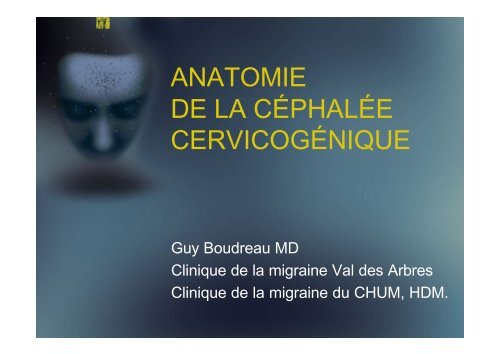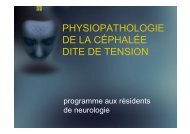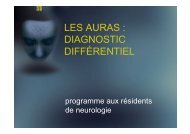anatomie de la céphalée cervicogénique - Chumneurologie.org
anatomie de la céphalée cervicogénique - Chumneurologie.org
anatomie de la céphalée cervicogénique - Chumneurologie.org
Create successful ePaper yourself
Turn your PDF publications into a flip-book with our unique Google optimized e-Paper software.
ANATOMIE<br />
DE LA CÉPHALÉE<br />
CERVICOGÉNIQUE<br />
Guy Boudreau MD<br />
Clinique <strong>de</strong> <strong>la</strong> migraine Val <strong>de</strong>s Arbres<br />
Clinique <strong>de</strong> <strong>la</strong> migraine du CHUM, HDM.
PRÉVALENCE ET<br />
INCIDENCE DE LA C.C.<br />
(indéterminée)<br />
CLINIQUE<br />
DE CÉPHALÉE<br />
(5520pts )<br />
Munich headache clinic<br />
• 13.8% : C.C.<br />
• 6% : C.C. PURE<br />
• 7.8% : C.C. +<br />
migraine + CDDT<br />
+ COM.<br />
• 2/3 sont <strong>de</strong>s femmes<br />
• Re<strong>la</strong>tion post trauma<br />
mal déterminée<br />
• OSLO whip<strong>la</strong>sh study<br />
C.C. : 8% après 6 sem.<br />
5% après 6 mois<br />
3% après 1 an
« WHATEVER IN THE NECK<br />
IS PRODUCING PAIN, IT MUST<br />
HAVE A NERVE SUPPLY »<br />
« If a given lesion is producing symptoms,<br />
then stimu<strong>la</strong>ting the affected structure<br />
or its nerve supply electrically should<br />
evoke or exacerbate symptoms, and<br />
subsequently anaesthetizing the structure<br />
which so produces symptoms or its nerve<br />
supply, should at least temporarly relieve<br />
symptoms » Bogduk N 1991
LES CÉPHALÉES ET<br />
LA COLONNE CERVICALE<br />
• Une douleur <strong>de</strong> <strong>la</strong> tête se localisant<br />
au cou n’a pas nécessairement<br />
une origine cervicale.<br />
• Un problème <strong>de</strong> cou peut irradier<br />
à <strong>la</strong> tête et à l’orbite.
LES CÉPHALÉES ET<br />
LA COLONNE CERVICALE<br />
TERMINOLOGIE<br />
• Selon l'HIS : douleur <strong>de</strong> <strong>la</strong> tête et<br />
<strong>de</strong> <strong>la</strong> face associée à un désordre<br />
du cou (11.2.1)<br />
• Selon l'IASP : <strong>céphalée</strong> <strong>cervicogénique</strong><br />
• Selon <strong>la</strong> CSST : séquelle douloureuse<br />
<strong>de</strong> l'entorse cervicale<br />
• Selon <strong>la</strong> SAAQ : TAEC<br />
• Selon France-Québec : DIM
IHS 11.2.1 : CÉPHALÉE<br />
OU DOULEUR FACIALE<br />
ASSOCIÉE À UN DÉSORDRE<br />
COU<br />
• Douleur localisée à <strong>la</strong> région occipitale,<br />
peut irradier au front, orbites, tempes,<br />
vertex, oreilles<br />
• Aggravée par mouvement du cou<br />
ou une position soutenue<br />
• 1 <strong>de</strong>s 3 suivants :<br />
- limitation passive<br />
- changement <strong>de</strong>s muscles<br />
- palpation douloureuse<br />
• Changements radiologiques
SIGNES ET SYMPTÔMES :<br />
• Uni<strong>la</strong>térale<br />
• Déclenchée par mouvement<br />
ou position<br />
• D.a.p. C2-C3 et GNO<br />
• Cervicalgie brachialgie vague<br />
• < <strong>de</strong> mobilité<br />
IASP (Sjaastad) :<br />
CÉPHALÉE CERVICOGÉNIQUE<br />
LA DOULEUR :<br />
• Épisodique ou continue<br />
• Modérée non pulsatile<br />
• Dans le cou, irradiante<br />
à l'orbite<br />
AUTRES CRITÈRES:<br />
• Bloc <strong>de</strong> C2 et GNO +<br />
• Histoire <strong>de</strong> trauma
DIAGNOSTIC :<br />
CÉPHALÉE CERVICOGÉNIQUE<br />
SIGNES ET SYMPTÔMES MINEURS :<br />
• Nausée, vomissement, ph.phobie<br />
• Oedème et flushing ipsi<strong>la</strong>térale<br />
• Étourdissement<br />
• Vision embrouillée ipsi<strong>la</strong>térale<br />
• Difficulté à avaler<br />
IHS MEMBERS HANDBOOK 1998
LES NERFS<br />
DE LA COLONNE CERVICALE<br />
L’INTÉRÊT DU NEUROLOGUE<br />
EST AU-DESSUS DE C3<br />
• Les nerfs prévertébraux<br />
• Les rameaux dorsaux<br />
• Le nerf vertébral<br />
• Les nerfs sinuvertébraux<br />
• Le GNO
LES NERFS<br />
PRÉVERTÉBRAUX<br />
(localisation)<br />
• C1-C4 :<br />
partie supérieure = rameau ventral<br />
• C5-C6 et (C7-C8?) :<br />
partie inférieure = rameaux gris<br />
communicants + rameau ventral<br />
Ce sont <strong>de</strong>s afférents sensoriels<br />
Bogduk N 1991
LES NERFS<br />
PRÉVERTÉBRAUX<br />
(site d'innervation)<br />
• Articu<strong>la</strong>tions antérieures<br />
• Disques antérieurs<br />
• Anneaux fibreux antérieurs<br />
• Ligaments et muscles prévertébraux<br />
Bogduk N 1991
LES RAMEAUX DORSAUX<br />
(localisation)<br />
• C1 : arche postérieure <strong>de</strong> l'at<strong>la</strong>s<br />
• C2 : <strong>la</strong>me postérieure <strong>de</strong> l'axis<br />
• C1 : 0 branche <strong>la</strong>térale ou médiane<br />
• C3-C8 : nerf spinal (trou <strong>de</strong> conjugaison)<br />
branche <strong>la</strong>térale (apophyse transverse)<br />
branche médiane (pilier articu<strong>la</strong>ire)<br />
Bogduk N 1991
LES RAMEAUX DORSAUX<br />
(localisation, particu<strong>la</strong>rités)<br />
• C1 : trop près <strong>de</strong> l'artère vertébrale<br />
• C2 : pas <strong>de</strong> repère pour le rameau postérieur<br />
• C3 : envoie plusieurs ramifications post.<br />
• C3-C8 : <strong>la</strong> branche médiane est séparée<br />
<strong>de</strong> <strong>la</strong> <strong>la</strong>térale par tendons du S.S.CA.<br />
Bogduk N 1982
LES RAMEAUX DORSAUX<br />
(cible d'innervation)<br />
• C1 : muscle du triangle sous occipital<br />
• C2-C8 : B.L. = muscles superficiels<br />
Bogduk N 1991<br />
B.M. = muscles profonds<br />
apophyse zygomatique<br />
(2 niveaux)
LES RAMEAUX DORSAUX<br />
(particu<strong>la</strong>rités)<br />
• C2, B.M. : GNO<br />
• C3, B.M. : 3e nerf occipital (cutané)<br />
• C4-C5, B.M. : branche cutanée<br />
• C1-C2, B.L. : plexus <strong>de</strong> hirsthfeld<br />
C1-C3, B.L. profon<strong>de</strong> : plexus cruveilhier<br />
• C3-C8, B.M. : contournent le pilier<br />
articu<strong>la</strong>ire, fixé par fascia <strong>de</strong> S.S.CA.<br />
Bogduk N.1982
ANATOMIE DU COU, VUE<br />
LATÉRALE, PLAN PROFOND G.<br />
Br. médiane<br />
postérieure<br />
C2=GON<br />
Br. <strong>la</strong>térale<br />
postérieure<br />
sectionnée<br />
Bogduk N., Spine, Vol.7 Num.4 1982<br />
Test diagnostique<br />
ou thérapeutique:<br />
bloc <strong>de</strong> racine<br />
médiane postérieure
Bogduk N., Spine,<br />
Vol.7,Num 4 1982<br />
ANATOMIE DU COU,VUE LATÉRALE,<br />
PLAN SUPERFICIEL G.<br />
Br. <strong>la</strong>térale<br />
postérieure<br />
Br. médiane<br />
postérieure<br />
Tendons du<br />
SSCa.
TERRITOIRE NOCICEPTIF<br />
DE C2-C3-C4-C5<br />
Examen :<br />
Mobilité, pincé-roulé<br />
Facettes + émergence <strong>de</strong>s nerfs<br />
Émergence du GNO<br />
Roulettes: hyper, hypoesthésie<br />
Dysesthésie, hyperalgésie, allodynie<br />
GNO V1<br />
Bogduk N, Spine. Vol.13,num.6 1988
LES NERFS VERTÉBRAUX<br />
(localisation)<br />
• Séries d'arca<strong>de</strong>s anastomotiques<br />
sympatiques<br />
• Rameaux gris + racine ventrale +<br />
nerf sinuvertébral (2 niveaux)<br />
Bogduk N.1991
LES NERFS VERTÉBRAUX<br />
(site d'innervation)<br />
• De C7-C2 : l'adventice <strong>de</strong> l'artère<br />
vertébrale, basi<strong>la</strong>ire, cérébrale<br />
postérieure<br />
Bogduk N. 1991
GANGLION DE C2<br />
IMPORTANT EN NOCICEPTION<br />
Oblique<br />
inférieur<br />
Ganglion<br />
<strong>de</strong> C2<br />
près <strong>de</strong><br />
l’artère<br />
vertébrale<br />
Lame<br />
postérieure<br />
axis
LES NERFS<br />
SINUVERTÉBRAUX<br />
• Rôle majeur en nociception<br />
• Ramification exclusive<br />
<strong>de</strong> <strong>la</strong> chaîne sympathique<br />
• Fonction nociceptive, proprioceptive,<br />
vasomotrice, vasosensorielle<br />
Blume H. 1995
LES NERFS<br />
SINUVERTÉBRAUX<br />
(localisation)<br />
• C1-C2 : origine?<br />
• C3-C8 : rameaux gris<br />
• Distribution transverse et<br />
intersegmentaire (4 niveaux)<br />
• Plus nombreux autour <strong>de</strong>s rameaux<br />
dorsaux et articu<strong>la</strong>tions zygomatiques<br />
Groen G.J. 1989
LES NERFS<br />
SINUVERTÉBRAUX<br />
(site d'innervation)<br />
• Dure-mère du canal médu<strong>la</strong>ire<br />
et <strong>de</strong> <strong>la</strong> fosse postérieure (C1-C2-C3)<br />
• Les enveloppes neuronales<br />
• Les ligaments longitudinaux (ant., post.)<br />
• Annuli fibrosi et disques<br />
Groen G.J.1989
NERFS SINUVERTÉBRAUX :<br />
CHAÎNE SYMPATHIQUE<br />
4 niveaux intersegmentaires<br />
Ganglions<br />
<strong>de</strong><br />
chaîne<br />
sympathique<br />
PLASTICITÉ, WIND-UP<br />
Disque<br />
Corps<br />
vertébral<br />
Gerbrand J. et al., The Amer. Jour, Anat. 188:282-296 (1990)
LES NERFS SINUVERTÉBRAUX<br />
MOELLE<br />
A.VERT ÉB.<br />
GAN. SYMP.<br />
DISQUE<br />
LIG. LON.A<br />
Groen G et al. The Amer. Jour. Anat. 188:282-296 (1990)
NERFS SINUVERTÉBRAUX, NOMBREUX<br />
AUTOUR DES RAMEAUX DORSAUX<br />
Rameaux<br />
ventr.<br />
dors.<br />
R. Ventral<br />
R. dorsal<br />
Ganglion<br />
sympathique<br />
Nerfs sinuvertébraux<br />
Gerbrand J et al. The Amer. Jour. Anat. 188 282-296 (1990)
NERF SPINAL, GANGLION SPINAL,<br />
NERF SINUVERTÉBRAL<br />
ARTÈRE VERTÉBRALE<br />
Lig. Long. A<br />
Corps vert.<br />
Lig. Long. P<br />
Gang. Symp.<br />
Art. vert.<br />
Ram. Vent.<br />
Ram. Dors.<br />
Rac. Vent.<br />
Rac. Dors.<br />
Geerbrand J et al. The Amer. Jour. Anat. 188: 282-296
C1-C2<br />
Plexus<br />
Hirsthfeld<br />
C2<br />
C1-C2-C3<br />
Plexus<br />
Cruveilhier<br />
Sinuvertébraux<br />
N. vertébraux
RÉSUMÉ<br />
RAMEAUX<br />
DORSAUX<br />
Articu<strong>la</strong>tion<br />
zygoapophysaire<br />
Muscles<br />
NERFS<br />
PRÉVERTÉBRAUX<br />
Art.<br />
at<strong>la</strong>ntooccipitale<br />
Art. at<strong>la</strong>ntoaxiale<br />
Muscles antérieurs<br />
Ligaments<br />
antérieurs<br />
Disques<br />
intervertébraux ant.<br />
NERFS<br />
SINUVERTÉBRAUX<br />
Disques<br />
intervertébraux<br />
Enveloppes<br />
neuronales<br />
Dure mère<br />
Ligaments<br />
longitudinaux
LE GRAND NERF<br />
OCCIPITAL<br />
TOPOGRAPHIE ET NOCICEPTION
GANGLION DE C2<br />
(particu<strong>la</strong>rités)<br />
• Derrière l'articu<strong>la</strong>tion at<strong>la</strong>nto-axiale,<br />
médian à l'articu<strong>la</strong>tion (rameau ventral,<br />
artère vertébrale, sac dural)<br />
• Important plexus veineux<br />
• Peu <strong>de</strong> chances <strong>de</strong> compression<br />
sauf si tête tournée<br />
Bogduk N 1981
GNO+A. Occipital<br />
At<strong>la</strong>s C1<br />
Dure-Mère<br />
Axis C2<br />
GANGLION DE C2<br />
Bogduk N. Cepha<strong>la</strong>gia, Vol. 1 41-50<br />
Test diagnostique et thérapeutique :<br />
bloc du ganglion <strong>de</strong> <strong>la</strong> racine <strong>de</strong> C2<br />
Traitement :<br />
décompression <strong>de</strong> <strong>la</strong> racine <strong>de</strong> C2
LE GNO<br />
(particu<strong>la</strong>rités)<br />
• S'étend jusqu'au nerf supraorbitaire,<br />
accompagne l'artère occipitale, important en<br />
nociception.<br />
• Émerge dans une aponévrose formée<br />
par <strong>la</strong> jonction du trapèze et du SCM.<br />
• Évitez les incisions parasagittales du cou<br />
(parcours horizontal).<br />
• Il ne transperce pas le trapèze.<br />
Poletti C. 1991, Vital J.M.1989, Bogduk N 1989
Bloc du GNO<br />
facile<br />
Bloc <strong>de</strong> C2<br />
difficile<br />
dangereux<br />
Bloc <strong>de</strong> C3<br />
plus facile<br />
C2,<br />
branche<br />
médiane<br />
postérieure<br />
= GNO
GNO: ROTATION DE LA TÊTE<br />
NORMALE<br />
ROTATION DROITE<br />
ROTATION GAUCHE<br />
RISQUE DE COMPRESSION
GNO: FLEXION EXTENSION<br />
NORMALE<br />
EXTENSION<br />
FLEXION<br />
Vital JM., et al. Surg. Radiol. Anat. (1989)11:205-210
CONVERGENCE<br />
ET SUPERPOSITION<br />
ANATOMIQUE<br />
DES AFFÉRENCES<br />
DU V SUR C1-C2-C3<br />
• 1/3 inférieur <strong>de</strong> C1 : maximale<br />
• 2/3 supérieur <strong>de</strong> C2 : maximale<br />
• C4 : minime<br />
• C5-C8 : 0<br />
• C1 converge V3, C2-C3 converge V1<br />
Kerr F.W.L. 1972
CAUDALIS<br />
Entrée<br />
du<br />
trijumeau Entrée<br />
<strong>de</strong><br />
C2-C3
CAUDALIS<br />
C1<br />
C2<br />
C3
CORNE POSTÉRIEURE C1-C2<br />
(chat)<br />
Rhizotomie<br />
VI gauche :<br />
dégénérescence<br />
<strong>de</strong>s fibres<br />
convergentes<br />
à CI-C2<br />
haut<br />
Kerr F., Brain research (1972) 561-572<br />
Rhizotomie<br />
C2 droite :<br />
dégénérescence<br />
<strong>de</strong>s fibres<br />
à CI-C2<br />
haut
CORNE POSTÉRIEURE C2-C3<br />
(chat)<br />
Rhizotomie VI<br />
gauche :<br />
dégénérescence<br />
<strong>de</strong>s fibres<br />
convergentes<br />
C2 haut<br />
Kerr F., Brain Research, (1972) 561-572<br />
Rhizotomie C2<br />
droite :<br />
dégénérescence<br />
C3 haut
Lance, Goadsby,<br />
Headache Mecanism<br />
and Management,<br />
Sec. edition<br />
RELATION<br />
TRIJUMEAU-CAUDALIS-C2<br />
CAUDALIS<br />
C2<br />
V1
RÉSUMÉ DE L’INNERVATION<br />
Re<strong>la</strong>tion nociceptive<br />
entre le trijumeau et CI-C2<br />
DEVANT<br />
DESSUS<br />
P<strong>la</strong>sticité<br />
et convergence<br />
VI-II-III et CI-C2<br />
DERRIÈRE<br />
DESSUS<br />
DEVANT
CONCLUSION<br />
• C2-C3<br />
ZONE DE TRANSITION<br />
fonctionnelle<br />
nociceptive<br />
proprioceptive<br />
vasomotrice
Ce patient est souffrant,<br />
croyons-le.




